Posts Tagged ‘Marketing/Category Design’
041 Marketing Lightning Strikes| Marketing PodStorm #3
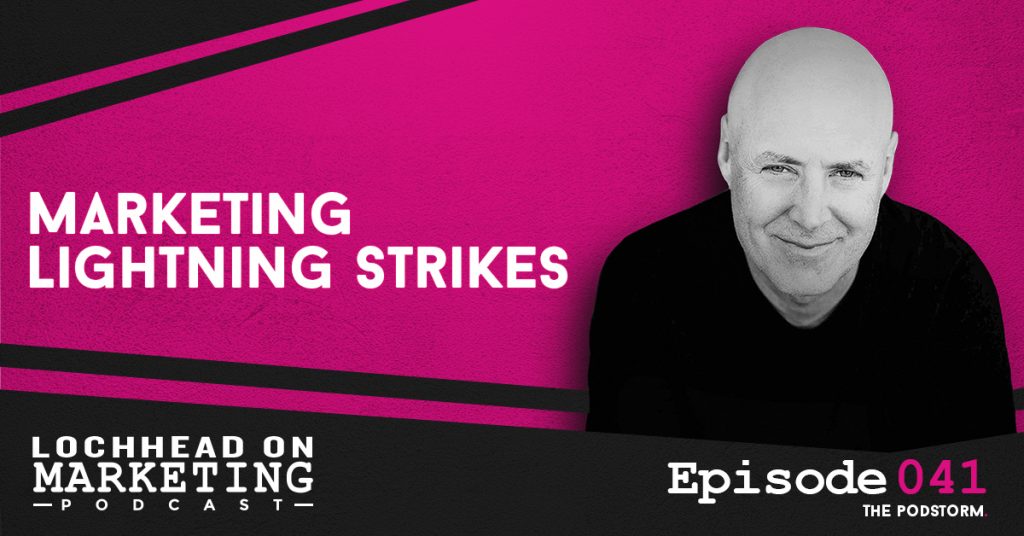
Podcast (lochheadonmarketing): Play in new window | Download (Duration: 12:00 — 11.0MB) | Embed
Subscribe: Apple Podcasts | Spotify | RSS | More
Welcome to Lochhead on Marketing, where we are trying the first world’s Marketing PodStorm — 30 days of strategies and ideas to help you create the future that you want because we believe that nothing legendary is going to happen, at any kind of scale, without legendary marketing.
In this episode, let’s discuss if you are either part of the noise or how you can rise above the noise with the power of a marketing lightning strike!
Reach and Frequency
It turns out that most marketing executions are predicated on an ancient idea on reach and frequency. The theory is, the more people who see your marketing efforts, the more successful your company will be.
“The reality is we get somewhere between 40,000 to 60,000 marketing messages a day. Reach and frequency really doesn’t work anymore.” – Christopher Lochhead
Christopher shares the idea of a lightning strike. It is taking a disproportionate amount of your marketing resources and execute in a very short period of time, against a small number of targets to get the maximum leverage.
Play Bigger: What is a Lightning Strike?
Now, let’s talk about how to stand out;
An excerpt from Play Bigger reads:
“A great lightning strike is a category-defining event. It evangelizes a new problem or an old problem that can be solved in a new way. It tells the world that this company knows how to define the problem and knows how to solve it. It makes potential customers believe that the company has the solution, and makes would-be competitors panic and call emergency board meetings. A strike is an event or coordinated series of events in a small window of time. It can take many forms. It can be tied to a product unveiling or a new round of funding. It could be a manufactured industry summit for the sole purpose of the strike.”
Do It Tight
The idea for a lightning strike comes from the movie industry. They stir up events to get maximum attention the two weeks before a movie launches.
What do you need? Christopher shares the following
- Pick a timing.
- Get super clear on your target audience.
- Make your target list as small as possible. You’re looking for leverage. You want to move your market category to action, by activating the most powerful, influential people in your category. If you get their attention and imagination and you get them talking. The idea is, “if you’re one of our Super Consumers, there is not a chance you’ll miss our lightning strike. You looking to create fast, word of mouth, leverage.
- Think of ALL of the components of the marketing mix that you use: Ads, PR, Social, Direct mail, email, podcasts, blogs, etc. Do a few legendary marketing executions that combined, will have maximum impact
To hear more about specific real-life lightning strikes event, download and listen to this episode.
Bio:
Christopher Lochhead is a #1 Apple podcaster and #1 Amazon bestselling co-author of books: Niche Down and Play Bigger.
He has been an advisor to over 50 venture-backed startups; a former three-time Silicon Valley public company CMO and an entrepreneur.
Furthermore, he has been called “one of the best minds in marketing” by The Marketing Journal, a “Human Exclamation Point” by Fast Company, a “quasar” by NBA legend Bill Walton and “off-putting to some” by The Economist.
In addition, he served as a chief marketing officer of software juggernaut Mercury Interactive. Hewlett-Packard acquired the company in 2006, for $4.5 billion.
He also co-founded the marketing consulting firm LOCHHEAD; was the founding CMO of Internet consulting firm Scient, and served as head of marketing at the CRM software firm Vantive.
We hope you enjoyed this episode of Lochhead on Marketing™! Christopher loves hearing from his listeners. Feel free to email him, connect on Facebook, Twitter, Instagram and subscribe on iTunes! You may also subscribe to his newsletter, The Difference, for some amazing content.
040 Making Your Market Category A Must Have | Marketing PodStorm Episode 2
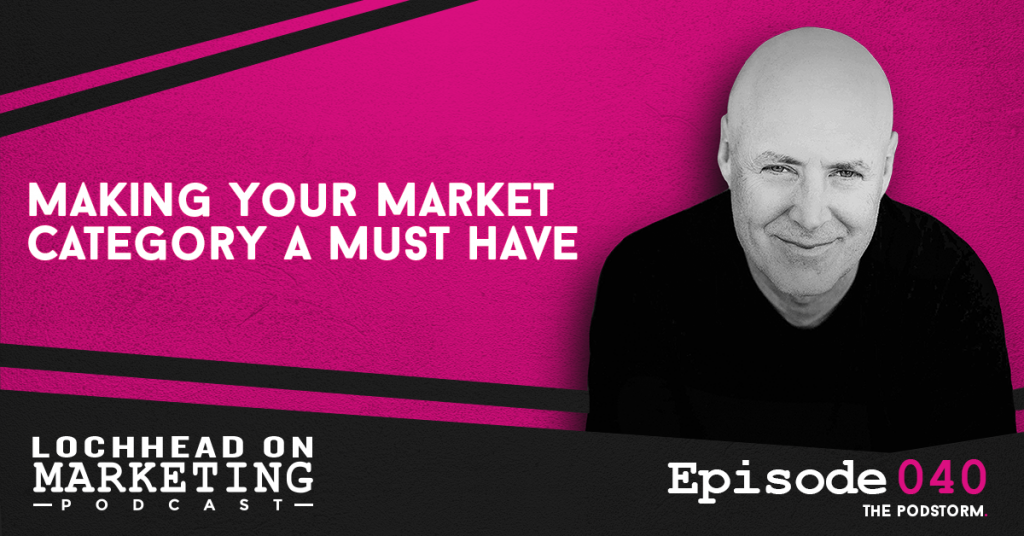
Podcast (lochheadonmarketing): Play in new window | Download (Duration: 6:41 — 4.6MB) | Embed
Subscribe: Apple Podcasts | Spotify | RSS | More
Welcome to Lochhead on Marketing, where we are trying the first world’s Marketing PodStorm — 30 days of strategies and ideas to help you create the future that you want because we believe that nothing legendary is going to happen, at any kind of scale, without legendary marketing.
In this episode, let’s talk about, arguably, the most important issue facing your marketing as you go forward powerfully: is your category a must-have, a nice to have or a don’t really need to have?
Customers Prioritize Categories When…
Christopher shares an important insight from a lot of CEOs and CMOs saying “our problem is that we are too much of a vitamin and not enough of an aspirin.” As it turns out, the more strategic, valuable, and urgent the market perceives a category, the greater the chances these customers will prioritize and buy from that business.
“I think there’s something very important to understand about what’s going on right now in the economy. We are all in a game of wallet share, much more than a game of market share. Customers’ wallets, as a result of the recession, are much smaller. They are going on a prioritization, deciding what is more important and what they can live without.” – Christopher Lochhead
Becoming a Must-have Is Job Number 1
Christopher mentions his observation about the mistake most companies are making as the economy starts to open up. They are evangelizing their brand, not their category.
“A brand is about us, is about our company it is about our product. The category is about customers, their problems, their opportunities. Categories are about customers, brands are about us. Right now, savvy marketers are focused on their customers and making their space, their category, critical.” – Christopher Lochhead
A Couple of Examples
The Washington Post has a very powerful tagline “democracy dies in darkness.” They are not hard-selling their brand, services, and company. The Washington Post is laying down a point of view about democracy and evangelizing this point of view results to elevating the value of Free Press.
“By evangelizing the category and keeping your brand more on the background, you also elevate your brand above everybody else in the category because, in the mind of the consumer, the company or the person evangelizing the category must be the category queen or king.” – Christopher Lochhead
To know more about how to make your market category a must-have, download and listen to this episode.
Bio:
Christopher Lochhead is a #1 Apple podcaster and #1 Amazon bestselling co-author of books: Niche Down and Play Bigger.
He has been an advisor to over 50 venture-backed startups; a former three-time Silicon Valley public company CMO and an entrepreneur.
Furthermore, he has been called “one of the best minds in marketing” by The Marketing Journal, a “Human Exclamation Point” by Fast Company, a “quasar” by NBA legend Bill Walton and “off-putting to some” by The Economist.
In addition, he served as a chief marketing officer of software juggernaut Mercury Interactive. Hewlett-Packard acquired the company in 2006, for $4.5 billion.
He also co-founded the marketing consulting firm LOCHHEAD; was the founding CMO of Internet consulting firm Scient, and served as head of marketing at the CRM software firm Vantive.
We hope you enjoyed this episode of Lochhead on Marketing™! Christopher loves hearing from his listeners. Feel free to email him, connect on Facebook, Twitter,Instagram and subscribe on iTunes! You may also subscribe to his newsletter,The Difference, for some amazing content.
039 This Recession Will Not Stand, Man | Marketing PodStorm Episode 1
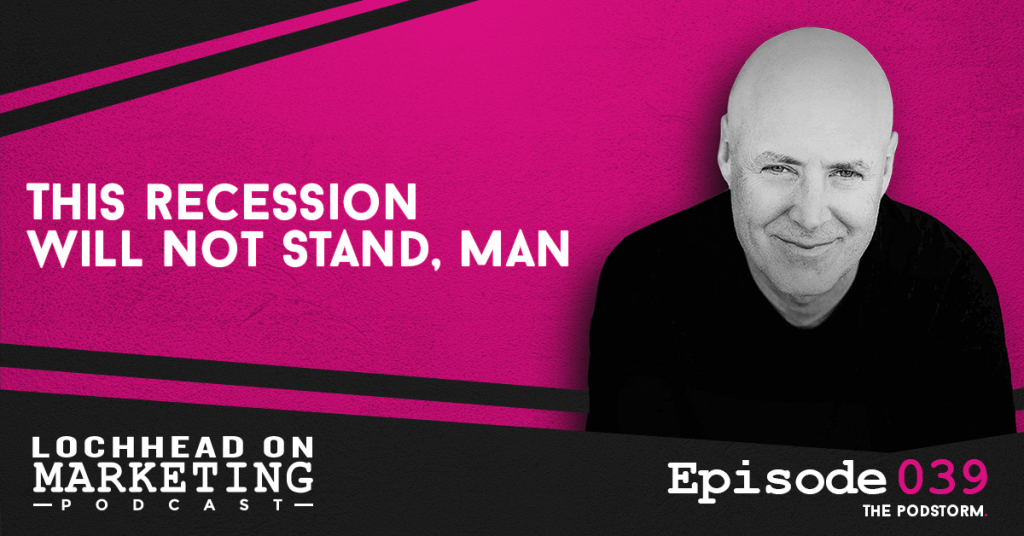
Podcast (lochheadonmarketing): Play in new window | Download (Duration: 13:10 — 9.0MB) | Embed
Subscribe: Apple Podcasts | Spotify | RSS | More
Welcome to Lochhead on Marketing, where we are trying the first world’s Marketing PodStorm — 30 days of strategies and ideas to help you create the future that you want because we believe that nothing legendary is going to happen, at any kind of scale, without legendary marketing.
In this episode, let’s talk about what is possible: it is possible to emerge from this downturn as a stronger business because this recession is not going to stand, man!
The HydraFacial Story
The legendary Peter Drucker once said: “the entrepreneur always searches for change, response to it and exploits it as an opportunity.” As hard as it is, particularly in this unprecedented time, legendary leaders are looking for opportunity and in many cases, they are finding it.
Christopher Lochhead conversed recently Clint Carnell, CEO of HydraFacial at Follow Your Different Episode 160, and Clint shares how they are dealing with the current C19 crisis, through radical business transformation.
How To Deal With “Ambush”
Last year was HydraFacial’s best year ever. When C19 hit, their entire category got stopped. Clint describes this as “being ambushed.” What do you do if this happens to your business?
“First of all, you summon your entrepreneurial spirit and you get, what my buddy Eddie Yoon call, thoughtfully aggressive and radically generous.” – Christopher Lochhead
HydraFacial partnered with a small company and they created the world’s first reusable cotton mask, infused with copper, which has natural anti-bacterial properties. Second, they entered the ventilator manufacturing business. Lastly, their call centers were converted to “helplines” to support the community during this crisis.
Roaring Out This Recession
Walter Frick in an article he wrote for Harvard Business Review cited amazing facts and figures that prove it is possible to turn your business around this recession.
“Recessions of 1980, 1990, and 2000, 17% of the 4,700 public companies they studied fared particularly badly: They went bankrupt, went private, or were acquired. But just as striking, 9% of the companies didn’t simply recover in the three years after a recession—they flourished, outperforming competitors by at least 10% in sales and profits growth. A more recent analysis by Bain using data from the Great Recession reinforced that finding. The top 10% of companies in Bain’s analysis saw their earnings climb steadily throughout the period and continue to rise afterward. A third study, by McKinsey, found similar results.” – Ranjay Gulati, Nitin Nohria, and Franz Wohlgezogen, Roaring Out of Recession
Christopher believes that you can come out of this downturn stronger when you commit and believe you can be a part of that 10%.
To know more about Christopher and why this recession will not stand, download, and listen to this episode.
Bio:
Christopher Lochhead is a #1 Apple podcaster and #1 Amazon bestselling co-author of books: Niche Down and Play Bigger.
He has been an advisor to over 50 venture-backed startups; a former three-time Silicon Valley public company CMO and an entrepreneur.
Furthermore, he has been called “one of the best minds in marketing” by The Marketing Journal, a “Human Exclamation Point” by Fast Company, a “quasar” by NBA legend Bill Walton and “off-putting to some” by The Economist.
In addition, he served as a chief marketing officer of software juggernaut Mercury Interactive. Hewlett-Packard acquired the company in 2006, for $4.5 billion.
He also co-founded the marketing consulting firm LOCHHEAD; was the founding CMO of Internet consulting firm Scient, and served as head of marketing at the CRM software firm Vantive.
Links:
How to Survive a Recession and Thrive Afterward, Walter Frick, Harvard Business Review
We hope you enjoyed this episode of Lochhead on Marketing™! Christopher loves hearing from his listeners. Feel free to email him, connect on Facebook, Twitter,Instagram and subscribe on iTunes! You may also subscribe to his newsletter,The Difference, for some amazing content.
038 The Future Needs You
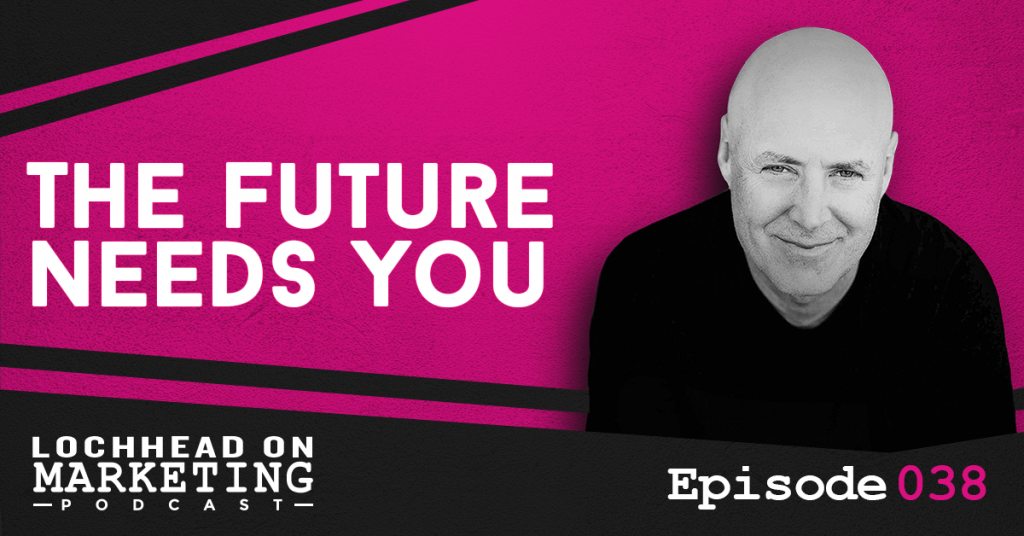
Podcast (lochheadonmarketing): Play in new window | Download (Duration: 7:11 — 4.9MB) | Embed
Subscribe: Apple Podcasts | Spotify | RSS | More
Today, let’s talk about why the future needs you and frankly, why the future needs some legendary marketing. Entrepreneurs, pay attention to this episode because the future needs you and your innovations to move the human race forward.
Going Back To How It Was
We hear a lot of discussion about how the business people plan to reopen businesses and how the entire workforce will get back to work. Christopher candidly gives his viewpoint for this: there is no going back to how it was before.
“I think frankly, there is nothing to go back to. It’s not about going back to work, it is about creating the future and I think that is where legendary marketing comes in.” – Christopher Lochhead
What Greatest Marketers Do
Christopher says the greatest marketers over time are the ones who move the world from the way it is now, to the way they want it to be. Further, he shares that legendary marketing is about making an exponential difference as opposed to creating an incremental change.
“I think we are witnessing the very beginning of the creation of a new future. Much is going to be different as we move forward. Work, the way we knew it, is different, Society, the way we knew it is different. I think people’s priorities are going to shift. I think what they value is going to shift. I think, therefore, what they are interested in buying is going to shift.” – Christopher Lochhead
The Power of Entrepreneurship
As a strong believer in the power of entrepreneurship and innovation to move the human race forward Christopher shares that most legendary marketers in the world have done exceptional work in doing exactly that.
“I think as we come out of this crisis there is a chance that we will begin to see the emergence of a whole new set of technologies, services, products and categories that design a more human future, frankly, a world that works for more of us, in a way that it never did before.” – Christopher Lochhead
To hear more about Why The Future Needs You and more information about Christopher, download and listen to this episode.
Bio:
Christopher Lochhead is a #1 Apple podcaster and #1 Amazon bestselling co-author of books: Niche Down and Play Bigger.
He has been an advisor to over 50 venture-backed startups; a former three-time Silicon Valley public company CMO and an entrepreneur.
Furthermore, he has been called “one of the best minds in marketing” by The Marketing Journal, a “Human Exclamation Point” by Fast Company, a “quasar” by NBA legend Bill Walton and “off-putting to some” by The Economist.
In addition, he served as a chief marketing officer of software juggernaut Mercury Interactive. Hewlett-Packard acquired the company in 2006, for $4.5 billion.
He also co-founded the marketing consulting firm LOCHHEAD; was the founding CMO of Internet consulting firm Scient, and served as head of marketing at the CRM software firm Vantive.
We hope you enjoyed this episode of Lochhead on Marketing™! Christopher loves hearing from his listeners. Feel free to email him, connect on Facebook, Twitter,Instagram and subscribe on iTunes! You may also subscribe to his newsletter,The Difference, for some amazing content.
030 How To Make Marketing Decisions
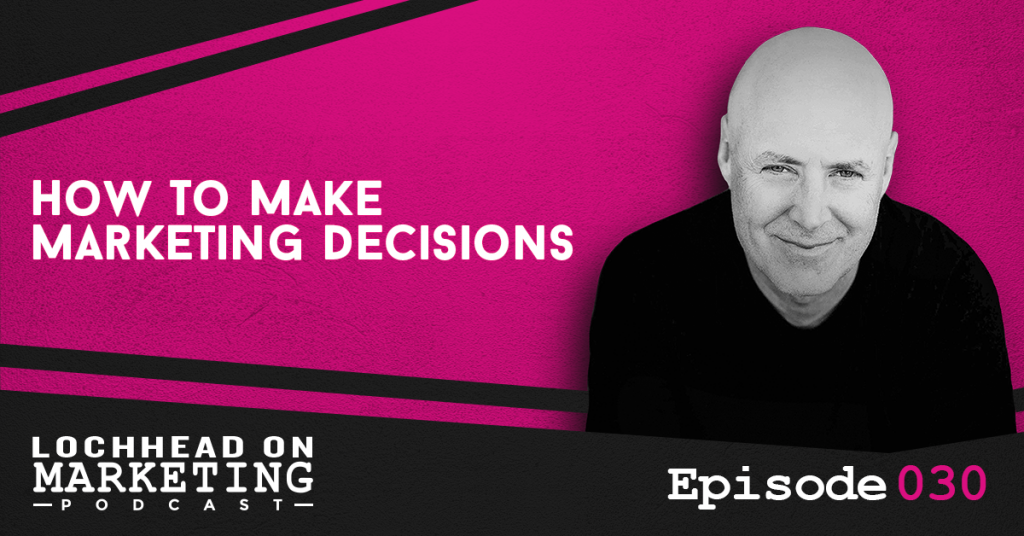
Podcast (lochheadonmarketing): Play in new window | Download (Duration: 7:21 — 10.1MB) | Embed
Subscribe: Apple Podcasts | Spotify | RSS | More
In this episode, let’s talk about the strategic lens required to make marketing decisions.
Marketing Decisions
Marketers, over and over again, continue to make this big mistake: they come up with marketing decisions without having a discussion around its context. Context, in terms of the “lens” they will use to come up with the decision.
“If you’re a regular listener and if you know me, you know one of my favorite expressions is, thinking about thinking is the most important kind of thinking.” – Christopher Lochhead
Overly Simplistic Lens
When people go and make a decision, they have an implied assumption that everyone on their team are on the same page. This holds true in different types of teams, whether its a department or a board room discussion.
In marketing, in particular, people use different kinds of lenses. Christopher points out that most people, even seniors executives, board members or giant public companies, use an overly simplistic lens in making a decision.
“Do I like it or do I not like it? Essentially the same lens that they use for naming a cat.” – Christopher Lochhead
Strategic Thinking
Christopher emphasizes that asking the questions whether you like something or not like something is just the same approach to naming a pet cat. This shouldn’t be done, especially when we’re talking about picking a category or designing a creative campaign or anything in between.
Hence, he is proposing the following lens when coming up with a marketing decision:
1) When you’re looking at any kind of marketing strategy or execution, ask, is this legendary?
2) Does this, execution, strategy or campaign enable us to design and dominate our category?
3) Does this decision drive near both term and long term revenue and customer loyalty?
To hear more about how to make marketing decisions, download and listen to the episode.
Bio:
Christopher Lochhead is a #1 Apple podcaster and #1 Amazon bestselling co-author of books: Niche Down and Play Bigger.
He has been an advisor to over 50 venture-backed startups; a former three-time Silicon Valley public company CMO and an entrepreneur.
Furthermore, he has been called “one of the best minds in marketing” by The Marketing Journal, a “Human Exclamation Point” by Fast Company, a “quasar” by NBA legend Bill Walton and “off-putting to some” by The Economist.
In addition, he served as a chief marketing officer of software juggernaut Mercury Interactive. Hewlett-Packard acquired the company in 2006, for $4.5 billion.
He also co-founded the marketing consulting firm LOCHHEAD; was the founding CMO of Internet consulting firm Scient, and served as head of marketing at the CRM software firm Vantive.
We hope you enjoyed this episode of Lochhead on Marketing™! Christopher loves hearing from his listeners. Feel free to email him, connect on Facebook, Twitter, Instagram and subscribe on iTunes! You may also subscribe to his newsletter, The Difference, for some amazing content.
028 Is Your Marketing Plan Radical Enough?
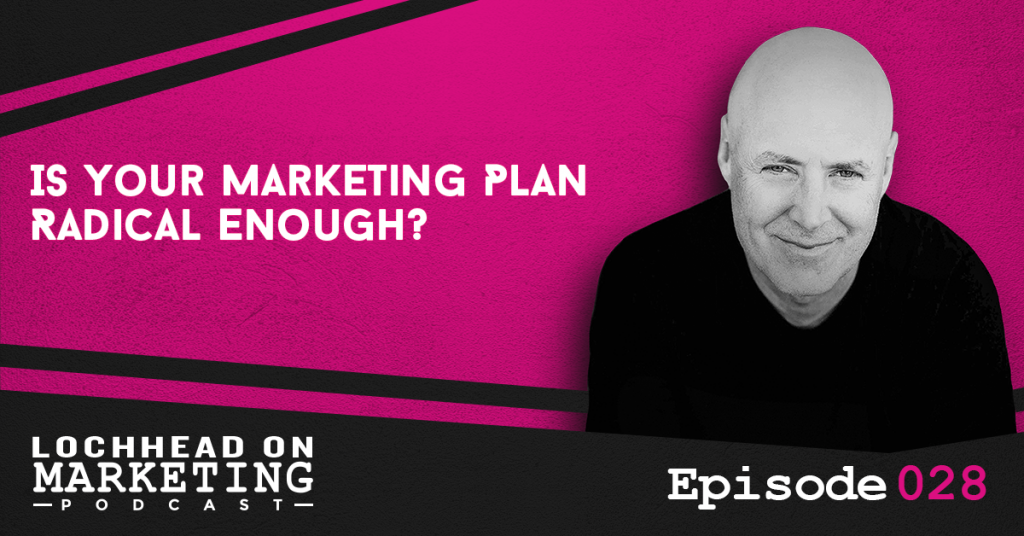
Podcast (lochheadonmarketing): Play in new window | Download (Duration: 13:53 — 19.1MB) | Embed
Subscribe: Apple Podcasts | Spotify | RSS | More
In this episode, Christopher Lochhead asks the question, “is your marketing plan radical enough?” Most marketing plans are predictable, uncreative and safe. He will share today how to do away with your usual marketing plan and craft a radical one.
3x CMO
Being an advisor to a lot of companies, Christopher shares how he has been part of creating, reviewing and critiquing a lot of these companies’ marketing plans. He further says that there are three things about these marketing plans: they are predictable, uncreative and safe.
Safe as in, most CMOs are more concerned with making their “internal customers” happy. The reason behind this is that most CMOs are trying to keep their jobs. Ultimately, this ends up in mundane marketing plans.
“The longer I do this, the more I think that, if it’s legendary, its probably radical, at least in some way.” – Christopher Lochhead
3 Ideas For Radical Thinking
Our job, ultimately in business is to be a leader, who enables our company to design and dominate a giant category that matters. The goal is to earn 2/3rds of the economics in a space that we created.
“That in my opinion that, is the real job of the CMO, CEO and the entire C-suite. So I urge you when building or evaluating a marketing plan, ask yourself: Will this plan enable us to design and dominate a giant category that matters?” – Christopher Lochhead
The second idea is that, do we have a radical way to evangelize our category POV?
Legends market the category, not the brand but this is one of the common mistakes marketing leaders make.
“You want them to buy into the thinking and to the language. and as they do that, they’ll see things the way you do and your new way or different way of doing things will become the defacto standard. What you’re really creating is this fear of missing out” – Christopher Lochhead
Lastly, ask yourself: what’s a radical way to generate leads and drive revenue? Legendary CMOs design the category for the mid-long term and drive revenue in the “ASAP, right now” term.
3 Questions
Again, to recap, here are the three radical ideas to consider before creating a marketing plan.
1) Will this plan, enable us to design and dominate a giant category that matters?
2) Do we have a radical way to evangelize our category POV?
3) What’s a radical way to generate leads and drive revenue?
To hear more about creating a radical marketing plan, download and listen to the episode.
Bio:
Christopher Lochhead is a #1 Apple podcaster and #1 Amazon bestselling co-author of books: Niche Down and Play Bigger.
He has been an advisor to over 50 venture-backed startups; a former three-time Silicon Valley public company CMO and an entrepreneur.
Furthermore, he has been called “one of the best minds in marketing” by The Marketing Journal, a “Human Exclamation Point” by Fast Company, a “quasar” by NBA legend Bill Walton and “off-putting to some” by The Economist.
In addition, he served as a chief marketing officer of software juggernaut Mercury Interactive. Hewlett-Packard acquired the company in 2006, for $4.5 billion.
He also co-founded the marketing consulting firm LOCHHEAD; was the founding CMO of Internet consulting firm Scient, and served as head of marketing at the CRM software firm Vantive.
We hope you enjoyed this episode of Lochhead on Marketing™! Christopher loves hearing from his listeners. Feel free to email him, connect on Facebook, Twitter, Instagram and subscribe on iTunes! You may also subscribe to his newsletter, The Difference, for some amazing content.
027 How To Create a New Category & Brand w/ Carrie Palin, CMO of $20B Splunk
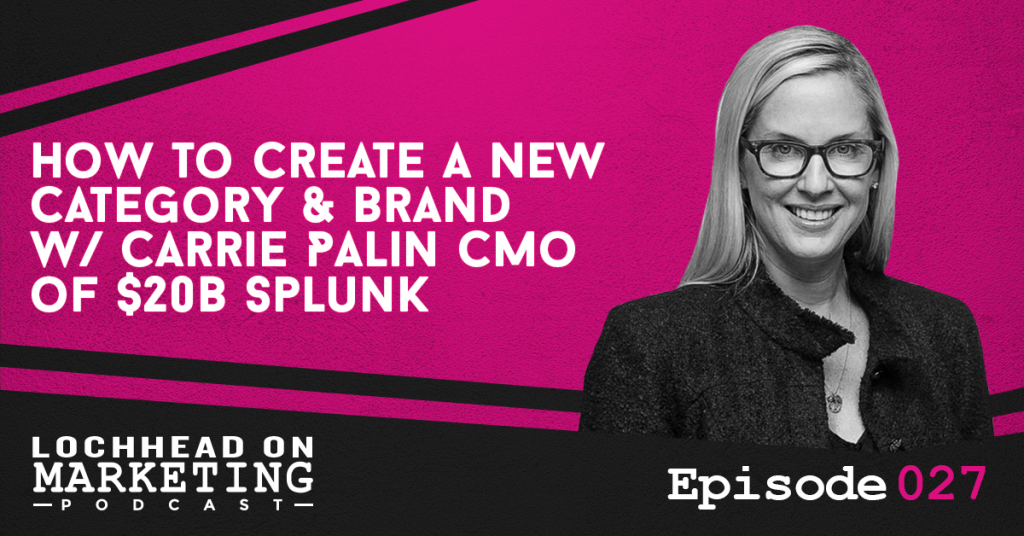
Podcast (lochheadonmarketing): Play in new window | Download (Duration: 25:10 — 34.6MB) | Embed
Subscribe: Apple Podcasts | Spotify | RSS | More
This special episode of Lochhead on Marketing is the actual conversation of Christopher Lochhead and Carrie Palin, CMO of software company Splunk, during their appearance at Hypergrowth San Francisco.
Carrie shares how she spearheaded the category creation of Data to Everything and brand re-launch of Splunk.
Splunk at Hypergrowth
Christopher Lochhead and Splunk CMO Carrie Palin were invited to speak at Hypergrowth San Francisco to talk about creating a new category and brand. Drift organized this awesome business and marketing conference. This conversation is a rare opportunity to go behind the scenes of a very successful, super high-growth company like Splunk.
“At Splunk, we’re very proud of our culture. We’re very proud of our history. There’s something we call Splunkiness.” – Carrie Palin
Splunk is a publicly-traded software company worth $20B and they have recently launched a new category called Data to Everything. They have also relaunched their brand, changing their logo from green and black to orange and pink.
Rough Start
Carrie shared that her forte is in demand generation and she found category creation and branding to be quite challenging. She notes that aside from having a great branding team, she had great bosses who believed in her vision.
It was a rough start for Carrie, as three days into her new role, she received a piece of unfortunate news about her ailing father. It was one of the challenging events of her life but she acknowledged that Splunk CEO and President had been supportive of her grief.
“Splunk stuck with me. They treated me like I’ve been there 20 years versus 3 days. Four months after that, it was crazier than I ever anticipated. Now that was through that, I know that it was absolutely the right place for me to be.” – Carrie Palin
On-boarding the BOD
Carrie shared amazing stories on how she on-boarded the Board of Directors with her ideas. She gave a lot of weight on conviction and commitment to the Board.
“Listen to your data. Turn your data into doing, which is exactly what our clients are doing. They’re doing really incredible things.” – Carrie Palin
To hear more about How To Create a New Category & Brand w/ Carrie Palin, CMO of $20B Splunk, download and listen to the episode.
Bio:
Carrie Palin has been Splunk’s Senior Vice President, Chief Marketing Officer since 2019.
Prior, Ms. Palin served as the Chief Marketing Officer at SendGrid, a digital communications platform company acquired by Twilio, from 2018 to 2019.
From 2016 to 2018, Ms. Palin served as the first Chief Marketing Officer and Senior Vice President at Box, a cloud content management company.
Ms. Palin served as the Vice President of Marketing for IBM’s Cloud Data Services and Analytics Software Division from 2015 to 2016.
She also previously spent over 15 years at Dell leading various marketing organizations. Ms. Palin holds a B.S. Communications degree from Texas Christian University.
Links:
We hope you enjoyed this episode of Lochhead on Marketing™! Christopher loves hearing from his listeners. Feel free to email him, connect on Facebook, Twitter, Instagram and subscribe on iTunes! You may also subscribe to his newsletter, The Difference, for some amazing content.
025 Category Creation & Category Design: A New Lens On Business
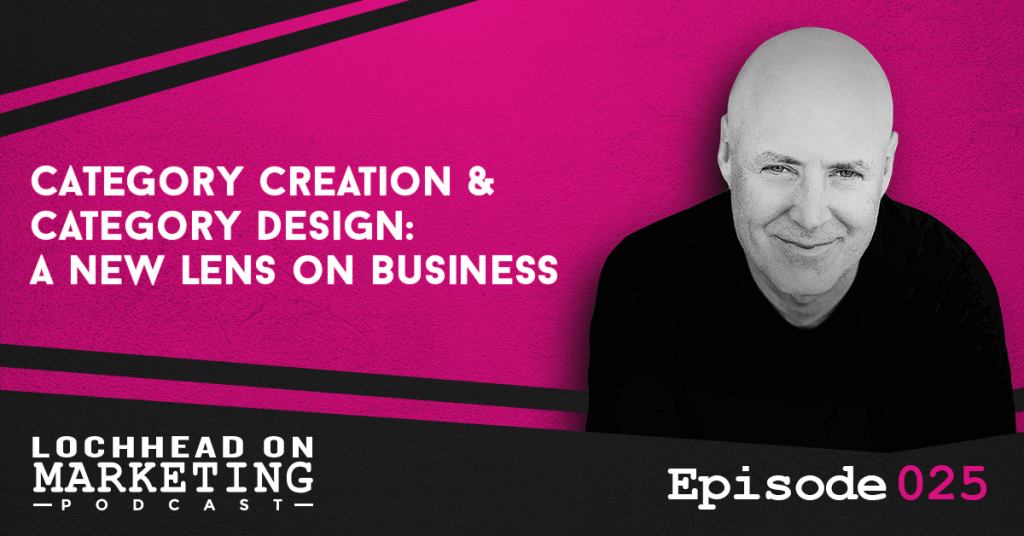
Podcast (lochheadonmarketing): Play in new window | Download (Duration: 19:55 — 27.5MB) | Embed
Subscribe: Apple Podcasts | Spotify | RSS | More
In this episode, Christopher Lochhead takes listeners on an exercise in developing their eye for category creation and category design. Category Design is a new level of thinking in business. It is a whole different approach to marketing and Christopher stresses its importance in building a legendary business.
See Things Differently
Kevin Mainey wrote in the book Play Bigger, that “category design is a new lens on business. Once you have that lens, you see things in a very unique way.” However, listeners often ask Christopher how can they specifically apply these to their businesses.
In this episode, Christopher uses a recent story in the WSJ as an example of how category design is powerful force, that most people don’t know is there. He breaks down a recent story about Google buying FitBit, with the hopes of assisting listeners on how to develop their eyes and ears on category design lens.
Google Buys Fitbit: A Category Design Example
Headline:
Google to Buy Fitbit, Amping Up Wearables Race
By Rob Copeland and Patrick Thomas
Updated Nov. 1, 2019
Sub-head:
Deal to acquire maker of wearable fitness products for $2.1 billion extends Google’s reach in consumer electronics
Wearables is a niche in the consumer electronics mega category.
Google reached a deal to buy wearable fitness products company Fitbit Inc. FIT 15.53% for roughly $2.1 billion, a move that intensifies the battle among technology giants to capture consumers through devices other than smartphones.
Category name before company name, its an example of the fact that people need to know what it is, before knowing who it is. The second sentence is framing the category battle.
For Google, the deal marks a further push into health. as it faces regulatory threats to its massive internet-search and advertising business.
Underscoring Google moving into mega category of health tech, then stating Google’s category king positing in search.
It also puts Google in renewed and direct competition with Silicon Valley neighbor Apple Inc., which in the past week said rising sales of wearables and related services were becoming a bigger driver of its business.
Framing the competition in new wearables category and wearables category growth.
Google’s parent Alphabet Inc. will spend just a sliver of its $121 billion cash hoard to branch out with Fitbit’s products. Alphabet’s $2.1 billion bid was for $7.35 a share in cash, a 19% premium to Fitbit’s closing price Thursday and more than 70% above where the stock was trading last week before deal talks were first reported by Reuters.
Speaks to the premium price category queens get in M&A.
Fitbit shares rose more than 15% to $7.14 on Friday, while Alphabet’s shares ticked up slightly.
The deal lands at a moment when Google and other tech giants are under scrutiny on a number of fronts over their competitive practices and dominance of certain businesses,
“certain businesses” means categories. This points to the domination category queens achieve.
including through acquisitions. But the Mountain View, Calif., company continues to expand aggressively.
Translation: moves into new categories through internal efforts and M&A.
Founded in 2007, Fitbit makes so-called wearables, or watches and bracelets that primarily track health information like heart rate. Such products have fascinated Silicon Valley
Speaks to early adopters embracing the category.
where technology executives of all ages proudly wear rings and other devices to track sleep and “hack” their own personal performance.
Wearables (category name) have proved far less popular with the broader public. Google several years ago launched a brand of smart glasses that attracted as much ridicule as buyers, and Snap Inc. likewise got a lukewarm response to its hyped Spectacles line.
Speaks to the trouble the “wearables” category have had breaking past early adopters to hit a main-stream tipping point. This is normal in the early days of a category. Also note, categories will NOT tip until a category queen emerges. Mainstream buyers want a safe option. AND they do NOT want to compare. They want to buy.
Fitbit traded for $45 soon after it went public in 2015, but the stock has cratered in the past few years as the company ceded market share to Apple and its smartwatch.
Speaks to the category battle with Apple
With its fitness offerings, Fitbit collects myriad and personal data on users that it in turn uses to suggest exercises and other lifestyle changes. And its sale is bound to raise issues around consumer privacy. In announcing the acquisition, Google said it wouldn’t use Fitbit data to help power its massive online advertising business.
Speaks to data as a seminal driver of category flywheels
“Similar to our other products, with wearables, we will be transparent about the data we collect and why,” Rick Osterloh, the head of Google’s hardware division, said in a statement. ”We will never sell personal information to anyone. Fitbit health and wellness data will not be used for Google ads. And we will give Fitbit users the choice to review, move, or delete their data.”
Apple in many ways is a model for what Google hopes to accomplish.
While the Apple Watch was initially a disappointment, sales have picked up lately; and the company’s AirPods were an immediate hit. The iPhone maker said on Wednesday that sales in its wearable business (category name) soared 54% in the latest quarter.
Facebook is also in the wearables mix. This fall the social-media giant reached a deal to buy CTRL-Labs Inc., a startup that develops devices that can interface with the brain.
“We’re talking about data that used to be impossible to collect on a mass scale,” Craig Hallum analyst Alex Fuhrman said. “Only since the beginning of the Fitbit era (new category pioneered by FitBit) have consumers been walking around with wearables that monitor their heart nearly 24 hours a day.”
Google’s hardware line (category) for now consists mostly of slow-selling products like the Chromebook laptop and Pixel smartphone.
Google has spent billions on targets like HTC Corp. , a smartphone maker, and Nest, a home hardware company, with little to show for it in sales, analysts say. Google doesn’t break out financial performance for its hardware division.
It hired Mr. Osterloh, a former Motorola president, in 2016 to steer the nascent unit. In an interview with The Wall Street Journal last month, Mr. Osterloh often referred to the hardware division as a “startup” within the conglomerate.
“I think eventually this will be a very large, important business,” he said.
Some observers remain skeptical. “The acquisition is another example of Google tilting at windmills” in hardware, analysts at Wedbush Securities wrote in a report Friday. “Google is uniformly bad at consumer products in our view, and appears to us to be intent on spending whatever it takes to prove our view wrong.”
Fitbit says it has sold more than 100 million devices world-wide since its founding, and currently has more than 28 million active users.
“Google is an ideal partner to advance our mission” said James Park, a Harvard University dropout who co-founded Fitbit.
Category creators tend to self-identify as mission driven
“With Google’s resources and global platform, Fitbit will be able to accelerate innovation in the wearables category, scale faster, and make health even more accessible to everyone,” he said in a statement.
The deal is expected to close next year, the companies said.
Fitbit’s results have been pressured in recent months. In July, it lowered its full-year revenue outlook after weaker-than-expected sales of its new smartwatch model, Versa Lite.
The smartwatches (sub-category name of wearbles category) are aimed at competing with popular offerings from Apple and Samsung Electronics Co.
Still, the company reported narrower losses in the second quarter as sales of its fitness trackers jumped 51% and the health division showed some strength. Fitbit is scheduled to release its third-quarter earnings report Nov. 6.
—Sarah E. Needleman contributed to this article.
***
So whats the point?
Here’s an article, that most people in business would read as, one company buying another company. In a marketing perspective, it underscores the fact that Google is buying the leading position in a hot new growth category.
“They’re not just buying FitBit or its products or its customers or its technology. They’re buying a position in a category, just like what they did, for example, when they bought Youtube.” – Christopher Lochhead
Christopher hopes that this exercise helped you understand category lens a little bit better.
“I would urge you in your next business discussion and the next arti8cle you read in the Wall Street Journal, or whatever else you read, start to think about these things from a category perspective. How they’re talking about, often is really a description of a larger set of dynamics happening over all in the marketplace.” – Christopher Lochhead
Bio:
Links:
023 Trendjacking Marketing and Public Relations w/ Paul Maher
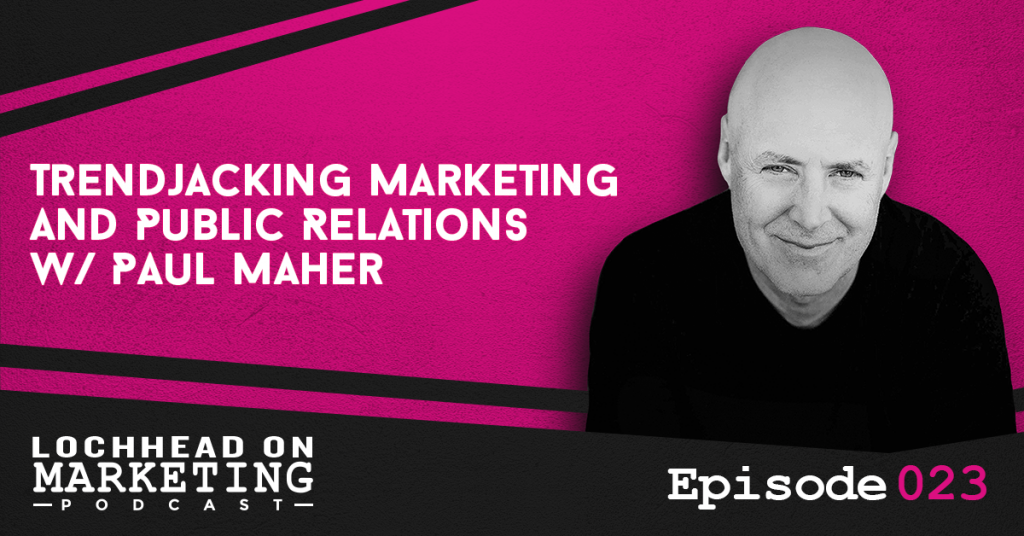
Podcast (lochheadonmarketing): Play in new window | Download (Duration: 27:54 — 38.5MB) | Embed
Subscribe: Apple Podcasts | Spotify | RSS | More
Today is another special episode of Lochhead on Marketing as Paul Maher, Founder of Positive Marketing (UK) joins us to talk about Trendjacking Marketing and Public Relations. His firm, Positive, won the SABRE Award for Best-earned Media Agency in Europe, Middle East, and Africa.Trendjacking
Paul Maher discusses the secret black art of marketing, PR, communications, and media called the trendjacking. This PR strategy is widely used nowadays as marketers aim to position themselves to become consistently relevant to their market.“Trendjacking is all about how do we take what’s happening in the news and attach ourselves to that, use that as an advantage to become an expert, to become known, to position ourselves effectively.” – Paul MaherChristopher and Paul have worked in several projects in the past and have actually the promulgators of trendjacking when they diverted a mergers and acquisition news of a competitor in the past.
Seven Secrets of Trendjacking
1. BE POSITIVE The news happens anyway, why not be in it? Category leaders make rather than observe the news. 2. BE PROVOCATIVE To do this you need to recognize the very definition of news is what you DIDN’T know, or as William Randolph Hearst, the biggest news baron of the pre-Facebook world famously said, ‘WHAT SOMEONE ELSE DOES NOT WANT YOU TO KNOW’. Get creative and find out who does not want to know what you want to say. 3. PREDICT (IT’S CALLED A NEWS CYCLE FOR A REASON) As well as great content, you need great timing. To know when is the optimal time to drop your bomb, you need to read patterns and become a news junkie, not an expert on everything from Celebrity Diets to Robot Brain Surgery, but at least stay across what’s going on in your sector. Preferably twice or more a day. Alternatively hire help, in the form of an agency or consultant who will. 4. PREPARE, PREPARE, PREPARE Set the trap and give yourself options. So perhaps have a set of pitches for each eventuality. England’s new Prime Minister Boris Johnston, also until recently one of the UK’s highest-paid newspaper columnists wrote two versions of an opinion piece, one for and one against Brexit. This way he hedged his bets and prevented a last-minute rewrite, we do this often for clients who want to trendjack major Government data announcements, such as Non-Farm jobs, GDP, etc. This brings us to. 5. BE PROMPT – ONLY EARLY BIRDS CATCH WORMS As a former journalist, dealing with hundreds of inbound calls each day, I would react to the ‘News no one else wants you to hear’ positively the first time. I also understand the second time a fresh angle is pitched, it is just plain old. Many of those who work on flagship news programs start their day earlier than the rest of the world. As the news rolls 24×7 it makes sense to make that early morning call or speak to Planning Departments the night before you drop. 6. BE PRAGMATIC – ORIGINAL BUT READY TO FLEX YOUR ANGLES Ambitious and original trendjackers are luckier trendjackers. Flip your angle, be more counter-intuitive, find the perfect image to accompany your trendjack. Smartest of all, chalk up your failures, wait for the news cycle to roll around and point to a ‘Told you so’ prediction when it does. We regularly issue ‘Open Letters’ to regulators, government bodies or even the entire tech industry when we scratch on a trendjack, just SO WE CAN GO BACK. Predictions are hard, especially in the future. So better to make them early and forget those which don’t come off. 7. BE PERSISTENT Recognize these perennial stories? They are not going away.- Users disappointed by tech outage
- Record good/bad holiday retail sales
- Sales of hot new thing break records
- CEO under pressure from board members
- Employment figure up/down last quarter

